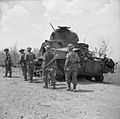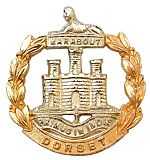Dorset Regiment
| The Dorset Regiment | |
|---|---|
|
Badge of the Dorset Regiment (1953–1958) | |
| Active | 1881–1958 |
| Country | United Kingdom |
| Branch |
|
| Type | Infantry |
| Role | Line Infantry |
| Size |
2 regular battalions 1 reserve battalion 1 Territorial battalion |
| Garrison/HQ | The Depot Barracks, Dorchester |
| Nickname | The Dorsets |
| Motto | Primus in Indis |
| March | Quick: The Maid of Glenconnel |
| Anniversaries | Plassey, 23 June |
The Dorset Regiment was a line infantry regiment of the British Army from 1881 to 1958, being the county regiment of Dorset. Until 1951, it was formally called The Dorsetshire Regiment, although usually known as "The Dorsets". In 1958 the regiment was amalgamated with the Devonshire Regiment to form the Devonshire and Dorset Regiment. In 2007, it was amalgamated with several other infantry regiments to form The Rifles.
History
The Dorsetshire Regiment was formed in 1881 under the Childers Reforms by the amalgamation of the 39th (Dorsetshire) Regiment of Foot and the 54th (West Norfolk) Regiment of Foot.[1]
The 1st Battalion took part in operations in the Tirah Campaign on the North West Frontier of British India in 1897–98, and the 2nd Battalion fought in the Second Boer War, participating in the Relief of Ladysmith.
World War I
During the Great War, nine hostilities-only battalions were formed, six battalions serving overseas. The 1st and 6th Battalions served on the Western Front throughout the war.[2]
The 2nd Battalion was in Poona, India, when war broke out and was shipped to Mesopotamia, where it was trapped in the Siege of Kut and captured by the Turks. (Of the 350 men of the battalion captured, only 70 survived their captivity.) During the siege, returning sick and wounded, and the few replacements who had been sent out, were unable to re-join their battalion, so they, and similar drafts of the 2nd Norfolk Regiment, were amalgamated into a scratch battalion forming part of the force attempting to relieve Kut.[3] This battalion was formally titled the Composite English Battalion, but was more commonly known as The Norsets; it was broken up in July 1916, when the 2nd Dorsets was re-constituted. The 1/4th Battalion of the Territorial Force served in India and Mesopotamia and 1/5th Battalion in India and Egypt and Palestine.
The 5th (Service) Battalion fought at Gallipoli, Egypt and Palestine, and the Western Front alongside the 1st and 6th Battalions.
In 1921, the 2nd Battalion was in India, where it helped put down the Moplah Rebellion. It was stationed in Palestine in 1936 to 1939, at the time of the Arab revolt.
Anglo-Irish War
The 3/4th Reserve Battalion was moved to Ebrington Barracks in Derry in April 1918.[4] In April 1920, during the Anglo-Irish War, soldiers from the regiment fired into a protesting crowd on Bridge Street, leading to riots and skirmishes which saw it fight alongside the Royal Irish Constabulary (RIC) and (later) Ulster Volunteers (UVF) against the Irish Republican Army (IRA).[5][6] Sporadic violence in the city continued until another large engagement in June, when the Dorsets and the UVF attacked the Bogside area of the city. A large IRA counter-offensive from the west ended the disturbances, which had seen 40 people killed since April.[7][8] Some RIC officers threatened to resign over the Dorsets' fraternisation and co-operation with the UVF.
World War II
In the Second World War, eight hostilities-only battalions were raised. The 1st Battalion was a regular army unit and part of 231st Infantry Brigade, alongside 1st Royal Hampshires and 2nd Devonshires, for the duration of the war, fighting in Malta, Sicily, and Italy. The 1st Dorsets landed on Gold Beach on D-Day as a part of the 50th (Northumbrian) Infantry Division and fought with the division in the Battle of Normandy and North-West Europe, until the division was withdrawn in late 1944 and used as a training division.
The 2nd Battalion was also a regular army unit and was a part of 5th Infantry Brigade, 2nd Infantry Division, throughout the war, participating in the Battle of France and the Dunkirk evacuation in 1940. In 1944, it took part in the Burma Campaign of 1944–1945 and the Battle of Kohima, still with the 2nd Division.
The 4th Battalion was an original 1st Line Territorial Army unit and, in 1939, raised a 2nd Line duplicate, the 5th Battalion, when the Territorial Army was doubled in size. The 4th and 5th Battalions were both in the 43rd (Wessex) Infantry Division, which was regarded as one of the best divisions of the British Army during the Second World War, participating in the Normandy Campaign, Operation Market Garden to the Rhine Crossing. They both served in the 129th Infantry Brigade.
The 30th Battalion, previously the 6th (Home Defence) Battalion, was with 43rd Infantry Brigade in North Africa and the invasion of Sicily, after which it spent the rest of the war in Gibraltar.
The 7th Battalion was raised in 1940 and was later transferred to the Royal Artillery and converted to the 110th Light Anti-Aircraft Regiment, Royal Artillery. The regiment served with the 43rd (Wessex) Division in North-West Europe from June 1944 to May 1945.
Post war and amalgamation
In 1958, the regiment amalgamated with the Devonshire Regiment to form the Devonshire and Dorset Regiment.
Battle honours
The regiment was awarded the following battle honours. Those from the two World Wars that are emblazoned on the Queen's Colour are indicated in bold:
- From 39th Regiment of Foot: Plassey, Gibraltar 1779–83, Albuhera, Vittoria, Pyrenees, Nivelle, Nive, Orthes, Peninsula, Maharajpore, Sevastopol
- From 54th Regiment of Foot: Marabout, Egypt, Ava
- Martinique 1794 (awarded in 1909 for service of the 39th Regiment), Tirah, Relief of Ladysmith, South Africa 1899–1902
- The Great War (13 battalions): Mons, Le Cateau, Retreat from Mons, Marne 1914, Aisne 1914, La Bassée 1914, Armentières 1914, Ypres 1915 '17, Gravenstafel, St. Julien, Bellewaarde, Somme 1916 '18, Albert 1916 '18, Flers-Courcelette, Thiepval, Ancre 1916 '18, Arras 1917, Scarpe 1917, Messines 1917, Langemarck 1917, Polygon Wood, Broodseinde, Poelcappelle, Passchendaele, St. Quentin, Amiens, Bapaume 1918, Hindenburg Line, Épéhy, Canal du Nord, St. Quentin Canal, Beaurevoir, Cambrai 1918, Selle, Sambre, France and Flanders 1914–18, Suvla, Landing at Suvla, Scimitar Hill, Gallipoli 1915, Egypt 1916, Gaza, El Mughar, Nebi Samwil, Jerusalem, Tell 'Asur, Megiddo, Sharon, Palestine 1917–18, Basra, Shaiba, Kut al Amara 1915 '17, Ctesiphon, Defence of Kut al Amara, Baghdad, Khan Baghdadi, Mesopotamia 1914–18
- The Second World War: St. Omer-La Bassée, Normandy Landing, Villers Bocage, Tilly sur Seulles, Caen, Mont Pincon, St. Pierre La Vielle, Arnhem 1944, Aam, Geilenkirchen, Goch, Rhine, Twente Canal, North-West Europe 1940 '44–45, Landing in Sicily, Agira, Regalbuto, Sicily 1943, Landing at Porto San Venere, Italy 1943, Malta 1940–42, Kohima, Mandalay, Mt. Popa, Burma 1944–45
Victoria Cross
The following member of the regiment was awarded the Victoria Cross:
- Private (later Corporal) Samuel Vickery, Tirah Campaign
-
.jpg)
Lieutenant Vizard, an officer serving with 4th battalion in the First World War
-

Men of the 2nd Dorsetshires passing a knocked out Lee tank at Mount Popa, April 1945
-

Soldiers of 5th Battalion during the Rhine crossing, March 1945
| Wikimedia Commons has media related to Dorsetshire Regiment. |
References
- ↑ "The Dorset Regiment at the archive of regiments.org". Web.archive.org. Retrieved 2014-04-29.
- ↑ "The Dorsetshire Regiment". 1914-1918.net. Retrieved 2014-04-29.
- ↑ "The 2nd Dorsets in Mesopotamia". Keepmilitarymuseum.org. Retrieved 2014-04-29.
- ↑ http://www.1914-1918.net/dorsets.htm
- ↑ http://cain.ulst.ac.uk/othelem/fox.htm#chap4
- ↑ The Outrages by Pearse Lawlor, pages 15-16
- ↑ http://www.derryjournal.com/news/derry-mayor-banned-flag-from-guildhall-in-1920-1-4722010
- ↑ The Outrages by Pearse Lawlor, pages 16-18
